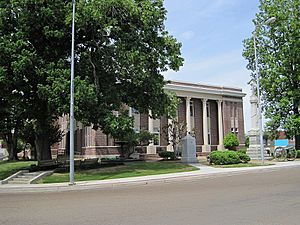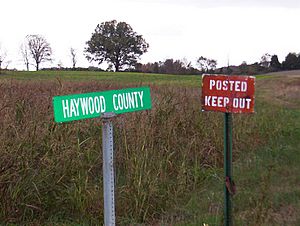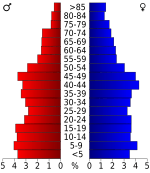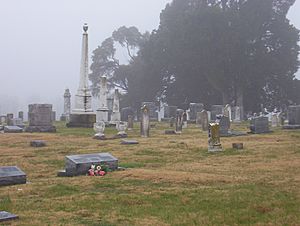Haywood County, Tennessee facts for kids
Quick facts for kids
Haywood County
|
|
|---|---|

Haywood County Courthouse
|
|

Location within the U.S. state of Tennessee
|
|
 Tennessee's location within the U.S. |
|
| Country | |
| State | |
| Founded | 1823 |
| Named for | John Haywood |
| Seat | Brownsville |
| Largest city | Brownsville |
| Area | |
| • Total | 534 sq mi (1,380 km2) |
| • Land | 533 sq mi (1,380 km2) |
| • Water | 0.9 sq mi (2 km2) 0.2%% |
| Population
(2020)
|
|
| • Total | 17,864 |
| • Estimate
(2023)
|
17,328 |
| • Density | 33.45/sq mi (12.916/km2) |
| Time zone | UTC−6 (Central) |
| • Summer (DST) | UTC−5 (CDT) |
| Congressional district | 8th |
| Website | Haywood County |
Haywood County is a county located in the U.S. state of Tennessee, in the region known as West Tennessee. As of the 2020 census, the population was 17,864. Its county seat and largest city is Brownsville. It is one of only two remaining counties in Tennessee, along with Shelby County, with a majority African-American population.
Contents
History
Haywood County was created from part of Madison County in 1823–24, and was named for Tennessee judge and historian John Haywood. The state legislature designated Brownsville as the county seat. Haywood County was later reduced in size, when both Lauderdale and Crockett counties were created from its territory.
For much of the county's history, agriculture, especially growing cotton, was the basis of the local economy. Before the Civil War, this was accomplished by a plantation system based on the use of slave labor. After Emancipation in 1865, the plantations were largely broken up, and tenant farming and sharecropping became the way that people controlled their labor.
Geography
According to the U.S. Census Bureau, the county has a total area of 534 square miles (1,380 km2), of which 533 square miles (1,380 km2) is land and 0.9 square miles (2.3 km2) (0.2%) is water.
Haywood County is situated on the southeastern edge of the New Madrid Seismic Zone, an area with a high earthquake risk.
Adjacent counties
- Crockett County (north)
- Madison County (east)
- Hardeman County (southeast)
- Fayette County (south)
- Tipton County (west)
- Lauderdale County (northwest)
National protected area
Demographics
| Historical population | |||
|---|---|---|---|
| Census | Pop. | %± | |
| 1830 | 5,334 | — | |
| 1840 | 13,870 | 160.0% | |
| 1850 | 17,259 | 24.4% | |
| 1860 | 19,232 | 11.4% | |
| 1870 | 25,094 | 30.5% | |
| 1880 | 26,053 | 3.8% | |
| 1890 | 23,558 | −9.6% | |
| 1900 | 25,189 | 6.9% | |
| 1910 | 25,910 | 2.9% | |
| 1920 | 25,386 | −2.0% | |
| 1930 | 26,063 | 2.7% | |
| 1940 | 27,699 | 6.3% | |
| 1950 | 26,212 | −5.4% | |
| 1960 | 23,393 | −10.8% | |
| 1970 | 19,596 | −16.2% | |
| 1980 | 20,318 | 3.7% | |
| 1990 | 19,437 | −4.3% | |
| 2000 | 19,797 | 1.9% | |
| 2010 | 18,787 | −5.1% | |
| 2020 | 17,864 | −4.9% | |
| 2023 (est.) | 17,328 | −7.8% | |
| U.S. Decennial Census 1790–1960 1900–1990 1990–2000 2010–2014 |
|||
| Race / Ethnicity (NH = Non-Hispanic) | Pop 2000 | Pop 2010 | Pop 2020 | % 2000 | % 2010 | % 2020 |
|---|---|---|---|---|---|---|
| White alone (NH) | 9,088 | 8,419 | 7,554 | 45.91% | 44.81% | 42.29% |
| Black or African American alone (NH) | 10,066 | 9,431 | 8,993 | 50.85% | 50.20% | 50.34% |
| Native American or Alaska Native alone (NH) | 18 | 25 | 33 | 0.09% | 0.13% | 0.18% |
| Asian alone (NH) | 18 | 21 | 26 | 0.09% | 0.11% | 0.15% |
| Pacific Islander alone (NH) | 3 | 0 | 6 | 0.02% | 0.00% | 0.03% |
| Other race alone (NH) | 3 | 21 | 56 | 0.02% | 0.11% | 0.31% |
| Mixed race or Multiracial (NH) | 77 | 147 | 358 | 0.39% | 0.78% | 2.00% |
| Hispanic or Latino (any race) | 524 | 723 | 838 | 2.65% | 3.85% | 4.69% |
| Total | 19,797 | 18,787 | 17,764 | 100.00% | 100.00% | 100.00% |
2020 census
| Race | Num. | Perc. |
|---|---|---|
| White (non-Hispanic) | 7,554 | 42.29% |
| Black or African American (non-Hispanic) | 8,993 | 50.34% |
| Native American | 33 | 0.18% |
| Asian | 26 | 0.15% |
| Pacific Islander | 6 | 0.03% |
| Other/Mixed | 414 | 2.32% |
| Hispanic or Latino | 838 | 4.69% |
As of the 2020 United States census, there were 17,864 people, 7,181 households, and 4,727 families residing in the county.
2010 census
As of the 2010 United States Census, there were 18,787 people living in the county. 50.4% were Black or African American, 45.9% White, 0.2% Native American, 0.1% Asian, 2.5% of some other race and 0.9% of two or more races. 3.8% were Hispanic or Latino (of any race).
Economy
The largest industry in Haywood County is agriculture. Haywood County grows more cotton than any other county in Tennessee and produced 189,000 bales in 2003 on 103,000 acres (420 km2). Soybeans were the county's secondary crop, followed by corn. Agriculture and other related businesses contributed more than $130 million to the Haywood County economy in 2004. By 2017, grains, oilseeds, drybeans, drypeas and tobacco drew the most income, but Haywood County still grew the most cotton in the state.
In 2009, under the leadership of Tennessee Governor Phil Bredesen and Haywood County Mayor Franklin Smith, a 3,836-acre (1,552 ha) tract in southwestern Haywood County near Stanton was designated for a state-supported industrial megasite, intended for a large-scale industrial or business development such as an automobile assembly plant. In September 2009, Tennessee's State Building Commission authorized spending of $40 million for purchase of the land. On September 27, 2021, it was announced that Ford and SK Innovation would construct a complex at the megasite called "Blue Oval City" to manufacture electric vehicles and batteries. The facility, which is expected to be operational in 2025, will cost approximately $5.6 billion, making it the most expensive single investment in state history, and employ approximately 5,700.
Communities
City
- Brownsville (county seat)
Town
Unincorporated communities
Notable residents
One of Haywood County's most notable residents was Sleepy John Estes, a blues guitarist songwriter and vocalist. Born in 1899 or 1900 in Ripley, Tennessee, he lived most of his life in Brownsville. He died on June 5, 1977, in Brownsville. Sleepy John is buried at Elam Baptist Church Cemetery in Durhamville, Lauderdale County.
Other notable county residents include:
- Tony Delk, a first round NBA draft pick spent his adolescent years in Brownsville.
- Hambone Willie Newbern, blues musician from the Brownsville area
- Singer Tina Turner spent her childhood in Nutbush, Haywood County. Her song "Nutbush City Limits" was based on the town.
- Elbert Williams, voting rights activist
See also
 In Spanish: Condado de Haywood (Tennessee) para niños
In Spanish: Condado de Haywood (Tennessee) para niños




